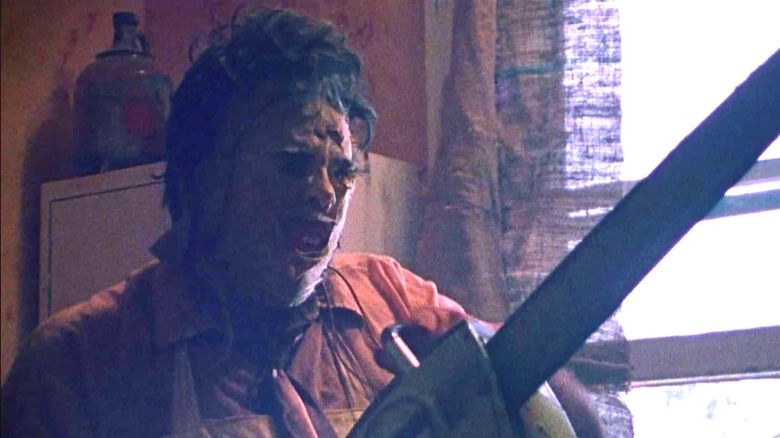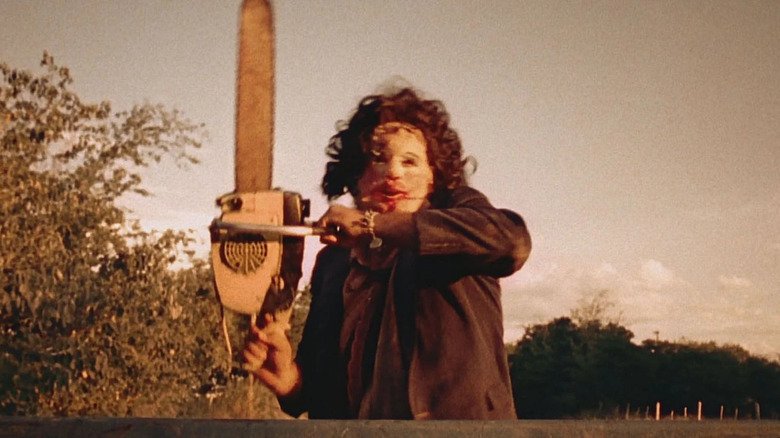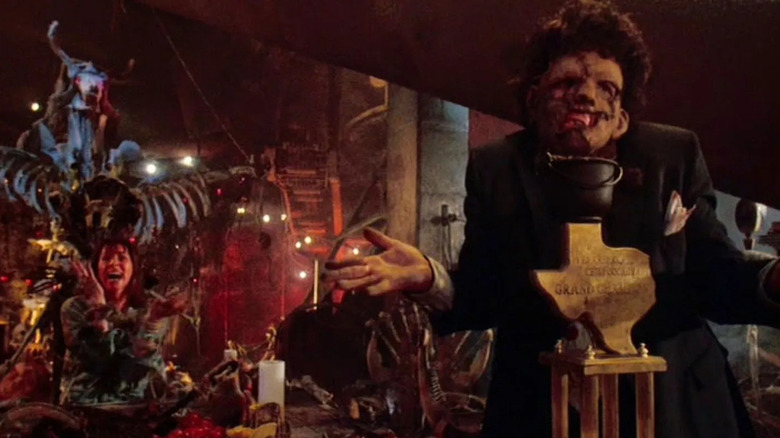A Legally Dubious Halloween Costume Inspired Tobe Hooper's Leatherface Design
Tobe Hooper's 1974 horror classic "The Texas Chain Saw Massacre" is 83 minutes of greasy, fetid, meat-scented pain and misery. This is a high compliment. It's a film that looks like it was made by the cannibals that star in it, focusing on the torture and pain of its doomed protagonists with the sickly enthused eye of an abattoir employee who loves their job just a little bit too much. Even the film stock itself, with its washed-out look and murky shadows, looks like it has been stored on the shelf of a slaughterhouse for several years. Over the years, it has lost none of its visceral power. Bafflingly, many filmmakers have attempted to recreate its power over the years with a long series of sequels and remakes that all fall short. At last count there have been nine Texas Chainsaw movies in toto.
Hooper, who died in 2017, was alternately an iconoclast and a commercial power player. When he wasn't working on Spielbergian horror hits like "Poltergeist," "Invaders from Mars," and the "Dancing with Myself" music video, he was working on ambitious genre-bending oddities like "Eggshells," "The Mangler" and "Djinn." Talking with Hooper reveals a man who is strongly drawn to the fringes.
"The Texas Chain Saw Massacre," as has been widely disseminated, was partly inspired by the crimes of Ed Gein, a real life serial killer who operated out of 1950s Wisconsin. The case study on Gein revealed that he used the various body parts of his victims — as well as body parts plundered from a nearby cemetery — to construct furniture and other objet d'art around his home. Bones and skin were (ulp) creatively transformed.
"Texas Chain Saw" featured similar crafts. And that puts us on the path to the, uh, Halloween costume.
Head Cheese
One of the more disturbing conceits of "Chain Saw" is that the film's hulking butcher Leatherface (Gunnar Hansen) wears a mask made of human skin. It's a powerful image that has been carried into a nine feature films, regardless of continuity. It was also, it turns out, based on a personal true story. In an interview that Hooper gave with the Offscreen Festival in 2015, the director revealed that he knew someone personally who actually made a mask of human skin, specifically to be worn to a Halloween party. That person was not a serial killer, but the family doctor. And, to clarify right away, the skin was obtained through ethical means. Well, maybe.
Hooper also talked briefly about his film's original title, which was a little less exciting but a lot more evocative. Hooper said:
"[The title] came later. The working title came to me when I was living in Austin and I would go do my shopping late at night. I was in the store and I saw head cheese, which is common enough. But it was the first time I had ever seen it. It looked like it had eyeballs in it and other nasty things. So that's where the working title 'Head Cheese' came from."
Head cheese, for those not yet in the know, is the common name for a cold meat terrine that contains parts of an animal's head. Typically, head cheese contains tongue. It's rarer that it will contain eyeballs and brains, although that's not unheard of. The cuts of head meat are set in aspic, and it is served cold or sliced up on a sandwich. There is no cheese in head cheese. Anyone who has seen head cheese up close can understand how Hooper might be moved to inspiration.
Birthing Hooper, birthing Leatherface
Hooper spoke more about his family doctor, unnamed in the interview. According to Hooper, his doctor claims to have pulled a Leatherface many years before, saying:
"Our family doctor treated everything from a skull fracture to immunization. He told me that when he was in pre-med school, he skinned a cadaver's face, cured and dried it, and then wore it to the school's Halloween party. That image stuck."
Yes, one can imagine that it stuck! Hooper does not go into details about the circumstances of his doctor's face-removal activities. There is no record as to what school this was or even who the doctor was. One would have to look deeply into Hooper's personal life to figure that out. It may be possible that Hooper's doctor was telling a fib just to be playfully ghoulish, but it's equally possible that he wasn't. When someone donates their cadaver to a medical school — an increasingly popular practice — it's meant to be dissected by students as a way of hands-on practical training. Dissecting human bodies has been part of medical training for centuries. Whether or not that training permitted students to make masks for Halloween parties would have to be a matter of consent. The legality of the issue is a little dubious.
Hooper's doctor also, as it so happens, helped deliver him when he was born. Hooper was impressed by his doctor's skill as well as his twisted sense of humor. The interviewer points out that Hooper has his doctor to thank for Leatherface, to which Hooper merely said "Yeah, he was a cool guy."


